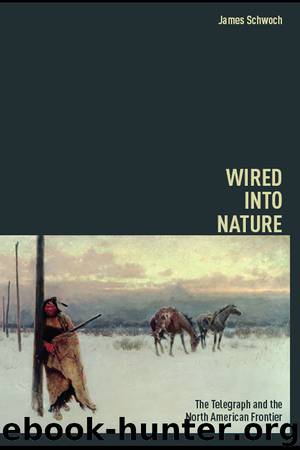Wired into Nature by Schwoch James;

Author:Schwoch, James; [Неизв.]
Language: eng
Format: epub
Publisher: University of Illinois Press
Map of Alaska, including surveyed telegraph route (map by Chicago CartoGraphics)
Examples from Alaska and the expedition such as quartermasters, uniforms, military commissions, and Confederate warships are some of the lingering signs of the ambiguous mix of both a corporation and an army.56 Kennicott told Baird that Bulkley did not appreciate the challenges of Arctic conditions and mistakenly expected men “to subsist on the Army ration and work with Army materials,” adding that for Alaska, Bulkley “runs Army a little too far for such a country.”57 Brought together hurriedly by the hand of Edwin Stanton in the crucible of rebellion and an existential crisis, Western Union and the Union Army did not seem at all hurried to dissolve many of the joint attributes and qualities of their own peculiar institution as soon as the battlefield confrontations of the Civil War halted. Anson Stager's 1866 budget report hinted at one component of their lingering intimacy. Bulkley and his military organization, his command structure, and his hand-wringing about marauding Confederate ships in the North Pacific also linger beyond the Civil War.
In some ways, the Western Union Telegraph Expedition and the USMT–Western Union–Union Army commingling raise the specter of the expedition as a sort of occupying army—or better, preoccupying army—in Russian Alaska. Ostensibly preoccupied with building an intercontinental telegraph, USMT–Western Union military officers and men, in some capacity, were continuously on the ground somewhere in Russian Alaska from their arrival in August 1865 until the Alaska Purchase and the subsequent transfer at Sitka on October 18, 1867. Spanning two years and two months, it was the longest continuous overseas presence of any American military force to that date—that is, if it was an American military force. Observing the transfer ceremonies atop Castle Hill in Sitka, Admiral George F. Emmons, commander of the USS Ossipee anchored in Sitka Harbor, observed that he was no longer in Russian America. Looking at the American flag now flying alone above Castle Hill, Emmons hoped that flag “will hereafter be the emblem that will embrace all of North America.”58 Military officers, telegraph experts, construction crews, corporate representatives, and a few Smithsonian–Chicago Academy–Northwestern naturalists on a scientific expedition—all these identities were in the mix, all representing the growing power and influence of the United States over western North America, all of them preoccupying Alaska.
Military Mindsets, Naturalists, and Differing Masculinities
Dall did not find much, if anything, useful in holding an officer rank while conducting business with the other officers of the expedition involved in construction and logistics. Kennicott had earlier told Baird that he found the military officers difficult, particularly a lieutenant colonel named William Hyde: “a low lived cunning customer—very Pecksniffian and an errant humbug.”59 Dall wrote his father a long letter in September 1865. He said the expedition was “organized on a military basis, which as it is carried out is a humbug.” Dall added “the red tapes and the forms are vigorously pursued, to the detriment of the organization and the interests of the Company.” The scientific expedition
Download
This site does not store any files on its server. We only index and link to content provided by other sites. Please contact the content providers to delete copyright contents if any and email us, we'll remove relevant links or contents immediately.
Whiskies Galore by Ian Buxton(41879)
Introduction to Aircraft Design (Cambridge Aerospace Series) by John P. Fielding(33064)
Small Unmanned Fixed-wing Aircraft Design by Andrew J. Keane Andras Sobester James P. Scanlan & András Sóbester & James P. Scanlan(32743)
Craft Beer for the Homebrewer by Michael Agnew(18140)
Turbulence by E. J. Noyes(7936)
The Complete Stick Figure Physics Tutorials by Allen Sarah(7307)
Kaplan MCAT General Chemistry Review by Kaplan(6867)
The Thirst by Nesbo Jo(6826)
Bad Blood by John Carreyrou(6552)
Modelling of Convective Heat and Mass Transfer in Rotating Flows by Igor V. Shevchuk(6391)
Learning SQL by Alan Beaulieu(6210)
Weapons of Math Destruction by Cathy O'Neil(6143)
Man-made Catastrophes and Risk Information Concealment by Dmitry Chernov & Didier Sornette(5921)
Digital Minimalism by Cal Newport;(5664)
Life 3.0: Being Human in the Age of Artificial Intelligence by Tegmark Max(5474)
iGen by Jean M. Twenge(5366)
Secrets of Antigravity Propulsion: Tesla, UFOs, and Classified Aerospace Technology by Ph.D. Paul A. Laviolette(5309)
Design of Trajectory Optimization Approach for Space Maneuver Vehicle Skip Entry Problems by Runqi Chai & Al Savvaris & Antonios Tsourdos & Senchun Chai(5011)
Pale Blue Dot by Carl Sagan(4912)
